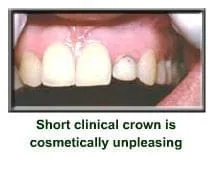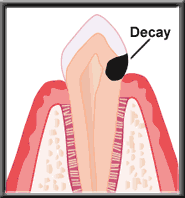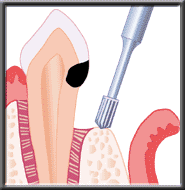The part of the tooth that is seen above the gum is called the clinical crown. When not enough of the clinical crown is showing, the gum must be moved up the root to expose more tooth. This is called crown lenghtening.
There are two situations in which crown lengthening is commonly performed: to improve appearance, and to allow a dentist better access to decay.
Below is an example of how the procedure works to enhance the esthetics of a smile.


(For further information on crown lengthening for cosmetic reasons, see Irregular Gum Levels ).
A second common use of crown lengthening is to access decay. If the dentist is unable to reach decay that is deep under the gum, the tooth will be lost. As a rule, simply trimming back the gum is not sufficient, for the bone would be exposed. Rather, the periodontist must reflect a flap (See Flap Surgery ), trim back the bone to allow for access to the decay, and then suture the gum back at the lower level. Sufficient bone must be removed to allow room below the decay for the gum to reattach to the tooth.

Decay far under gum

Flap reflected to access decay

Bone trimmed for access
to decay and to allow
room for gum to reattach

Gum replaced with decay
visible for dentist to
restore with filling or crown
Most crown lengthening procedures are very straightforward, and there is little or no post-operative discomfort. Sutures and dressing are removed after about 2 weeks, and in many cases a 5-minute "touch-up" surgery is done after 4-6 weeks to establish ideal tissue form. This secondary procedure requires no sutures or dressing, and has no post-operative discomfort.
If a crown is to be placed in a cosmetic area, the restorative dentist should wait 6-8 weeks following crown lengthening before taking final impressions. This ensures that the gum, which shrinks slightly as it re-attaches to the tooth during healing, is in its final position. If the margin of the crown is placed at the gum level before final healing, and additional shrinkage occurs, the results may be unsightly. A temporary crown can be placed two weeks after surgery if the patient desires to cover the exposed root during this healing period.